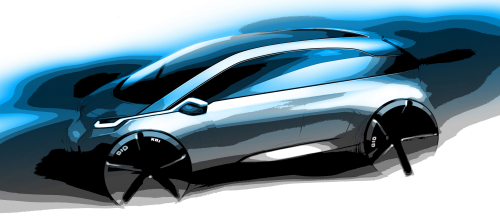
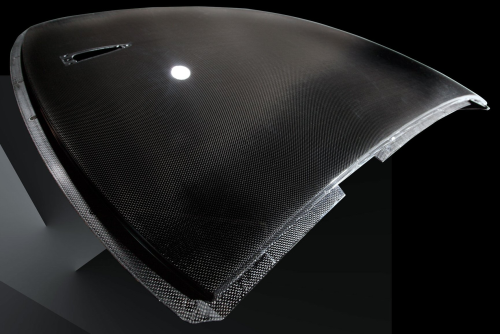
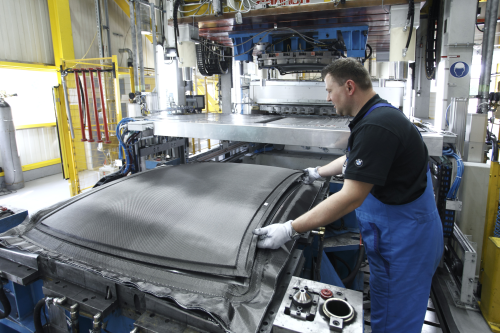
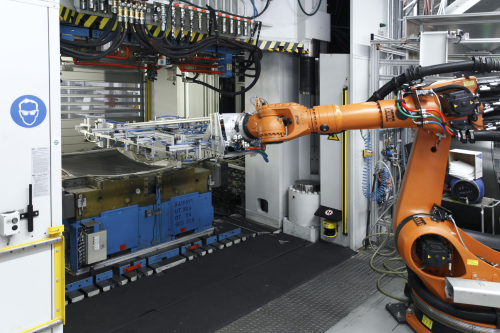
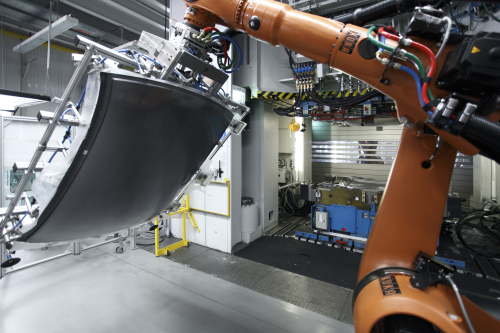
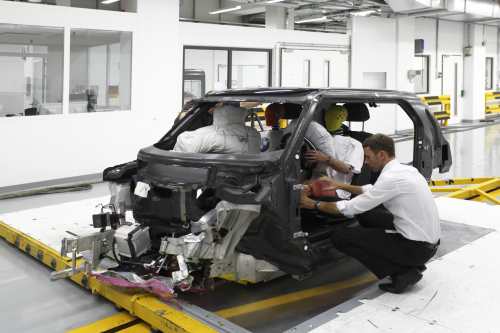
According to United Nations forecasts, around 70% of the world’s population will be living in towns and cities by 2050. Today, there are already more than 130 cities worldwide with over 3 million inhabitants. BMW sees non-polluting electric vehicles as one option for personal transport within these urban environments. The Megacity Vehicle (MCV) is one possible concept for a sustainable city car. Scheduled for market launch in 2013, it will be sold under a BMW sub-brand.
Lightweight design
For an electric car lightweight design is particularly important because, alongside battery capacity, weight is the key factor limiting the car’s range, BMW explains. The lighter the car, the longer the distance it will be able to travel – simply because the electric drive system will have less mass to move. Lower vehicle weight also makes for better performance: a lightweight car accelerates faster, is more agile through corners, and brakes to a standstill more quickly. Lower accelerated mass means that energy-absorbing crash structures can be scaled back, which in turn saves weight.
So the objective is to keep the overall weight of an electric vehicle as low as possible from the outset. However, the fundamental components of an electric car do not make this easy. The drivetrain of an electric car is much heavier than that of a vehicle with a combustion engine (full tank of fuel included). An electric drive system (including battery) weighs around 100 kg more, with the battery accounting for most of this. To cancel out this extra weight, BMW has been working on lightweight design principles and the use of new materials, such as carbon fibre reinforced plastics (CFRP).
CFRP has a number of benefits in vehicle body construction, notes BMW. While it is at least as strong as steel, CFRP it is also around 50% lighter. Aluminium, by contrast, would save only 30% in weight terms over steel. Extensive use of lightweight CFRP in the Megacity Vehicle will give the car both a longer range and improved performance. The car’s handling is also improved since the stiffness of CFRP makes the driving experience more direct. CFRP also enables a higher level of comfort, as the stiff material dampens energy inputs effectively so that unwanted vibrations (rattles and shakes) are eliminated.
CFRP is also corrosion-resistant and does not rust, giving it a longer lifespan than metal and making complex corrosion protection measures unnecessary.
CFRP enables the construction of an extremely lightweight car body without compromising passenger safety. High rigidity, combined with its ability to absorb an enormous amount of energy, makes CFRP extremely damage-tolerant. This is demonstrated in Formula One race cars, where the CFRP driver cell survives intact after high speed impacts.
A new vehicle architecture
As well as focusing on lightweight design, BMW has looked at the vehicle architecture of an electric car. BMW’s MINI E and BMW ActiveE electric vehicle concept projects have shown that cars designed to be powered by combustion engines and subsequently converted to run on electric power do not represent an optimum solution. These ‘conversion cars’ are comparatively heavy, and accommodating the big, heavy battery modules and special drive electronics required for electric power is difficult. BMW has therefore developed a new body design which it calls the LifeDrive concept.
The LifeDrive concept consists of two horizontally separated, independent modules – the Drive module, an aluminium structure, and the Life module, a CFRP structure.
The Drive module – an aluminium chassis – forms the foundation of the vehicle and integrates the battery, drive system, crash elements and suspension into a single construction. The energy storage system weighs around 250 kg and has dimensions similar to those of a child’s mattress. The priority in the conception of the Drive module was to integrate the battery – the largest and heaviest element in the electric vehicle in terms of construction – into the vehicle structure so that it would be operationally reliable and safe in a crash.
The Drive module is divided into three areas. The central section houses the battery and is surrounded with aluminium profiles. Two crash-active structures in the front and rear provide the necessary crumple zone in the event of a front or rear impact. The Drive module also houses the components of the electric drive unit and numerous suspension components. The electric drive system is, as a whole, more compact than a comparable combustion engine, accommodating the electric motor, gear assembly, power electronics and axles within a small space.
The Life module consists primarily of a high strength, lightweight passenger cell made from CFRP. It is mounted on the load-bearing structure of the Drive module. The integration of all the drive components into the Drive module allows the removal of the transmission tunnel present in a conventional car. The Megacity Vehicle therefore offers significantly more room for its occupants within the same wheelbase.
This ‘fit for purpose’ design of the LifeDrive concept therefore integrates all the key features of an electric car – including the large, heavy battery and compact drive elements – into an impact-resistant structure. This concept also results in weight savings, leading to longer range and improved performance, plus enhanced safety for the passenger and the battery.
The LifeDrive concept also has benefits in production, reports BMW. The vehicle’s frame construction is extremely practicable when it comes to the production of moderate unit figures, while the use of parallel working processes ensures a high level of flexibility. The horizontal separation of the modules would allow the two elements to be manufactured separately before being put together virtually anywhere in the world, in a straightforward assembly process.
Investing in carbon fibre
As part of its plans for the Megacity Vehicle and its CFRP passenger cell, BMW has invested in its own production facilities for carbon fibre. In October last year it announced a joint venture with German carbon fibre producer SGL Group to manufacture carbon fibres and fabrics for the automotive industry. BMW and SGL have has cooperated in the area of carbon fibre composites for many years. The joint venture plans include the construction of two new sites: one in North America for the carbon fibre production; and the other in Germany for fabrics. SGL holds 51% of the shares in the joint venture and the BMW Group 49%.
The overall investment for the joint venture is expected to reach approximately €230 million. Construction of the production facilities will begin in 2010. In the final stage of development, annual carbon fibre and fabric production is expected to be in the range of several thousand tons a year. The joint venture will create more than 180 jobs.
In April this year, SGL and BMW announced the location of the joint venture’s US carbon fibre manufacturing plant – Moses Lake, Washington. During the initial phase of development, US$100 million will be invested and 80 local jobs created. The carbon fibres manufactured at Moses Lake will be used exclusively for the BMW Megacity Vehicle.
The Moses Lake facility will convert polyacrylonitrile (PAN) based precursor produced by a joint venture between SGL Group and the Japanese company Mitsubishi Rayon (MRC) into carbon fibres. These fibres will then be converted into lightweight carbon fibre fabrics at the second SGL/BMW joint venture site in Wackersdorf, Germany. These fabrics will be used to manufacture CFRP parts and components at the BMW Group’s Landshut plant in Germany. The assembly of the Megacity Vehicle will take place at BMW’s plant in Leipzig, Germany, where a range of BMW 1 Series and the BMW X1 models are currently being built.
Mass production
CFRP has previously been thought of as too expensive and too difficult to work with for use in a volume-produced vehicle, but BMW believes it now has the manufacturing experience necessary. The BMW Landshut Innovation and Technology Centre has been researching CFRP for over 10 years. In 2003, BMW began volume production of CFRP components and it has been ramping up output ever since. Today the Landshut plant is mass producing CFRP roofs for the BMW M3 and M6 models and CFRP bumper supports for the M6.
The company has built up a high level of expertise in CFRP production processes and has steadily refined and automated the CFRP production process at the Landshut plant so that it is now possible to mass-produce CFRP body components cost efficiently and to a high quality standard.
|
BMW is not the only company looking seriously at the automotive applications for carbon fibre. In June, Austrian company Carbo Tech received a €150 million order from McLaren Automotive to produce carbon fibre monocoques (one-piece passenger cells) for McLaren's new range of sports cars. Carbo Tech will manufacture the McLaren designed carbon chassis (the MonoCell) for series production models of a new generation of McLaren Automotive road cars over the next 8 years. The first Carbo Tech carbon fibre reinforced plastic (CFRP) components will form the chassis of the McLaren MP4-12C. The carbon monocoque in the 12C weighs less than 80 kg and satisfies all crash test requirements for series-production vehicles. In April, Japanese carbon fibre producer Toray Industries Inc and German car maker Daimler AG signed a joint development agreement to develop automotive parts made of CFRP. The companies want to start using the carbon fibre composite parts in Daimler’s Mercedes-Benz models within the next three years. Under the agreement, Toray and Daimler plan to develop CFRP automotive components by utilising High Cycle Resin Transfer Moulding (RTM), a process developed by Toray. Toray sees the expansion of its Carbon Fiber Composite Materials Business in the automotive market as one of its top priorities. Daimler intends to expand the use of CFRP parts and the range of vehicles using these parts. US headquartered carbon fibre supplier Zoltek has formed a new subsidiary to develop high-volume applications for carbon fibres within the automotive industry. “We have long identified the automotive industry as the biggest single potential user of our low cost, high-performance carbon fibres,” says Zoltek Chairman and CEO Zsolt Rumy. |
The process starts with nonwoven carbon fibre fabrics. In contrast to a woven fabric, in these fabrics the fibres are not placed at right angles to one another and interwoven, but are all aligned in the same plane. Weaving would kink the fibres and detract from their properties.
Fabric is cut to shape and then preformed using a heat source to give a fabric stack a stable, three-dimensional contour. Several preformed stacks can then be joined together to form a larger component. In this way it is possible to produce components with a large surface area, which would be difficult to manufacture from aluminium or sheet steel. This has benefits for vehicle body design and manufacture. For example, mounting parts or other features can be integrated directly into the component. Also, complex structural components and entire body modules with varying wall thicknesses can be produced in a single moulding tool.
The next stage of production is a high pressure resin transfer moulding (RTM) process involving the high-pressure injection of resin into the preforms. BMW has developed its own process, moulding tools and production equipment to ensure high productivity combined with very high quality.
After resin injection and curing all that remains is the finishing work such as precise contour cutting and the insertion of any further openings that may still be required. This finishing work is performed by a water jet cutting machine. For CFRP applications, this technique does require certain modifications, which BMW has introduced.
BMW says it has also developed a concept for recycling production waste into commercial-quality raw material. This system is said to allow a substantial proportion of carbon fibre waste to be returned to the production process. Thanks to a special refining procedure, the resulting material can even be used as a substitute for primary fabric.
Further development
BMW is confident that with its 10 years worth of accumulated in-house expertise and experience it has achieved its long-term goal: the mass production of CFRP components. The company has invested heavily in acquiring and developing in-house competences – process capabilities and employee skills – giving it a high level of self-sufficiency and making it largely independent of external constraints.
But even if this objective has been met, other challenges remain for the Megacity Vehicle. Development work on the energy storage systems continues, to make them more compact, lighter, and less expensive, and to improve energy density and consequently vehicle range. The final challenge will lie with the market – will car buyers want an electric vehicle?
This article was published in the September/October 2010 issue of Reinforced Plastics magazine.




